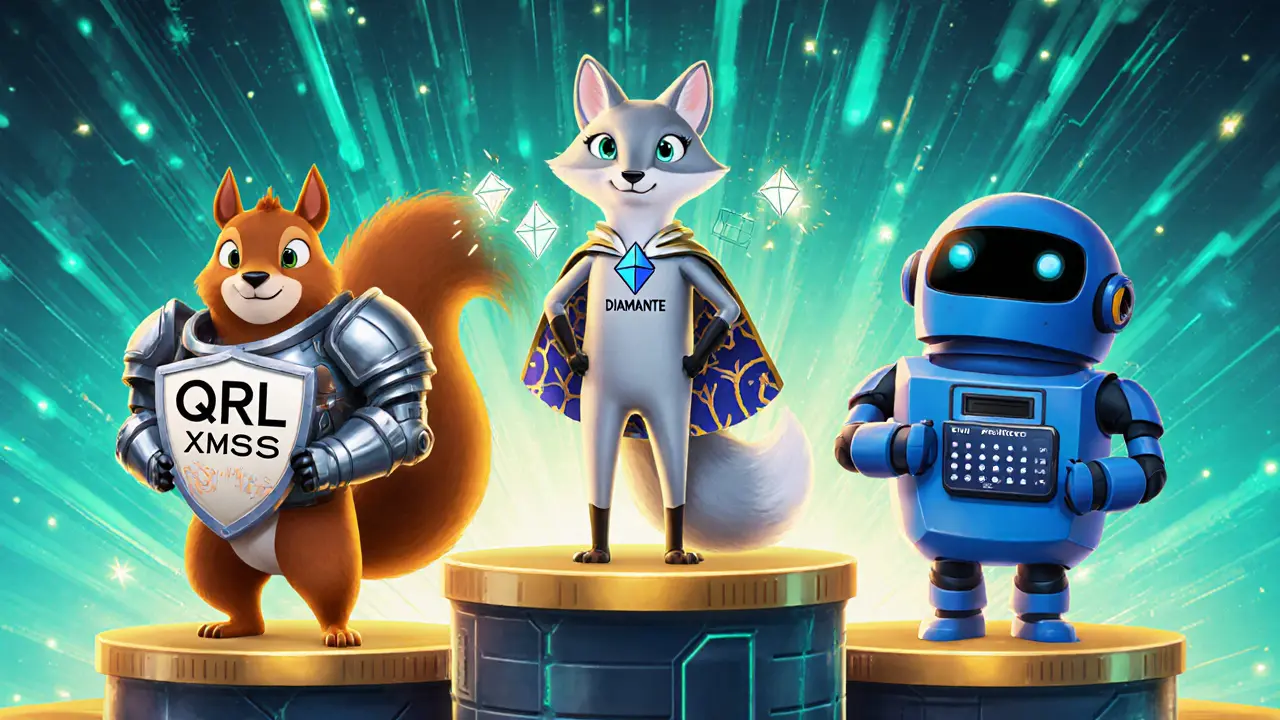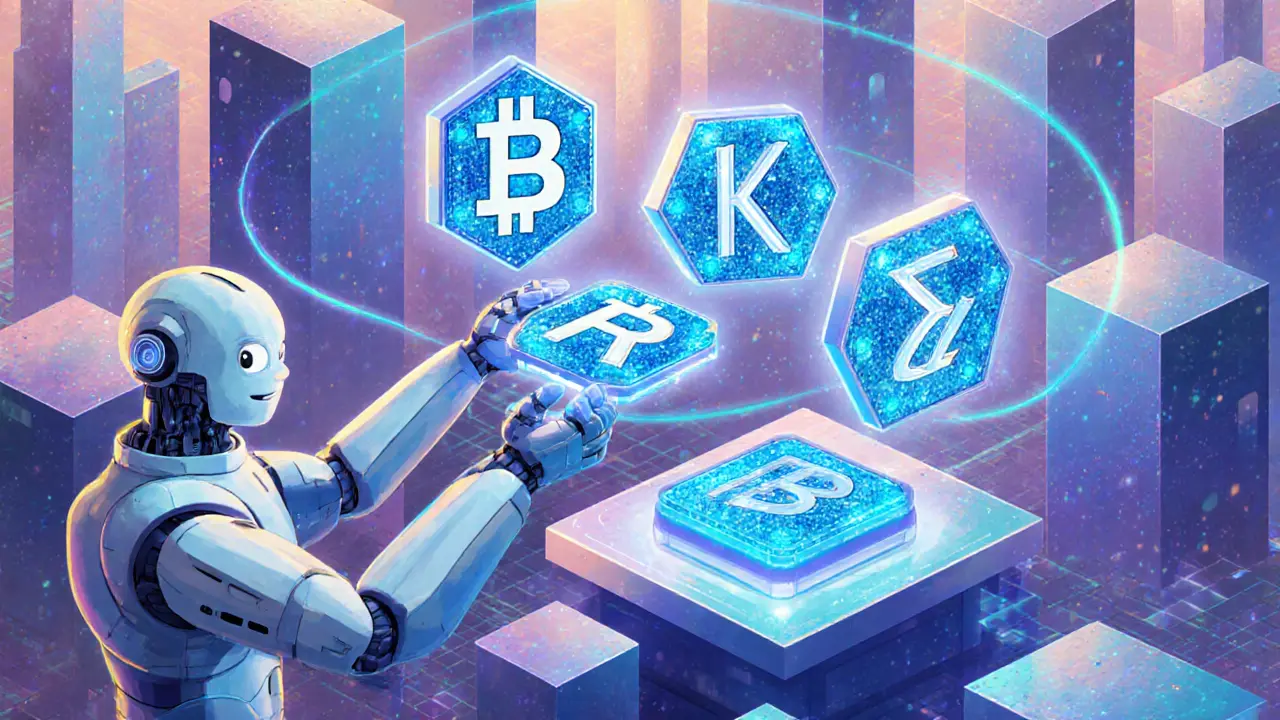Key Takeaways
- Quantum‑safe blockchains replace vulnerable ECC/RSA keys with post‑quantum algorithms like Kyber and Dilithium.
- Three main approaches dominate the scene: purpose‑built chains (QRL), hybrid enterprise solutions (Diamante), and migration layers for existing platforms (Project Zond).
- Post‑quantum signatures are larger (kilobytes vs. hundreds of bytes), so watch storage and bandwidth costs.
- Microsoft’s three‑phase roadmap aims for full quantum‑safe services by 2033, pushing early adoption before 2029.
- Start experimenting now with the Open Quantum Safe (OQS) liboqs library - it’s the de‑facto bridge for integrating PQC into any blockchain.
What is a quantum‑safe blockchain?
In plain terms, a quantum‑safe blockchain is a distributed ledger that can survive a future attack from a large‑scale quantum computer. Classic public‑key schemes like ECDSA or RSA could be cracked by Shor’s algorithm, so these networks swap in post‑quantum cryptography (PQC) - math that stays hard even for quantum machines.
The shift isn’t just a “nice‑to‑have” upgrade. Blockchains store data forever, and a breach today could undermine years of transaction history. That’s why the community started embedding NIST‑standardized algorithms (CRYSTALS‑Kyber for key exchange, CRYSTALS‑Dilithium for signatures) as soon as the standards were announced in July2022.
Why the Rush? The Quantum Threat Timeline
Microsoft’s August2025 security blog warned that “future scalable quantum computing could break public‑key cryptography methods currently in use.” Most experts peg a practical, breaking quantum computer at 10‑15years out - around 2035. But because blockchains are immutable, the safe window closes much earlier. Gartner predicts the quantum‑safe blockchain market will jump from $127M in 2024 to $894M by 2028, so the money’s already moving.

Leading Quantum‑Safe Projects
Below are the heavy‑hitters you’ll hear about on developer forums, conference panels, and white‑paper decks.
Quantum Resistant Ledger (QRL)
QRL was built from the ground up to be quantum‑proof. It uses XMSS - a hash‑based signature scheme approved by NIST. Because XMSS is stateful, each signature can only be used once, which adds a layer of security but also complicates wallet design. The upside? XMSS keys are smaller than lattice‑based signatures, keeping transaction sizes modest.
Community vibe: A very active Discord, frequent developer meet‑ups, and a clear focus on long‑term security over short‑term features.
Diamante
Diamante takes a hybrid route - permissioned ledgers for enterprises that embed NIST‑standard algorithms (Kyber for key exchange, Dilithium for signatures) right at the base layer. The design eliminates the “retrofit” headache: you get quantum security without a massive fork later.
The trade‑off is size. Dilithium signatures can be several kilobytes, which drives up storage and bandwidth needs. Diamante offsets this with compression tricks and a modular architecture that lets you enable PQC only on sensitive channels.
Project Zond
Born at ETHDenver2025, Zond promises “Ethereum compatibility with quantum protection.” Its Zond Virtual Machine (ZVM) mirrors the Ethereum Virtual Machine (EVM), so existing Solidity code runs unchanged - only the cryptographic primitives swap in. Zond ships a dual‑signature wallet that can sign with both ECDSA (for legacy) and Dilithium (for quantum). This makes migration painless for dApp developers.
What developers love: No need to relearn the whole toolchain. What they worry about: The extra signature data expands block size, potentially throttling throughput.
Legacy Giants Trying to Catch Up
Bitcoin and Ethereum are still experimenting. Bitcoin research papers discuss swapping ECDSA for post‑quantum schemes, while Ethereum’s roadmap (Ethereum3.0) includes testnets for quantum‑resistant cryptography. Neither has a production‑ready solution yet, but the groundwork is laid.
Comparison at a Glance
| Project | Core PQC Algorithm | Signature Size | Compatibility | Target Use‑Case |
|---|---|---|---|---|
| QRL | XMSS (hash‑based) | ~1KB | Standalone chain | Security‑first crypto |
| Diamante | CRYSTALS‑Kyber / Dilithium | 2‑5KB (Dilithium) | Permissioned + trustless hybrid | Enterprise & compliance |
| Project Zond | CRYSTALS‑Dilithium (EVM‑wrapped) | ~3KB | EVM‑compatible | Dev‑friendly migration |
| Bitcoin (research) | Various (e.g., Lattice, Code‑based) | >5KB (prototype) | Legacy chain, upgrade required | Long‑term resilience |
| Ethereum (roadmap) | Kyber/Dilithium planned | >5KB (prototype) | EVM, phased rollout | Smart‑contract ecosystem |
Implementation Challenges - What You’ll Run Into
- Key & signature bloat. Expect 2‑10× larger data payloads. That means higher storage fees on public chains and the need for optimized node software.
- Performance overhead. Verifying a Dilithium signature can take several milliseconds more than an ECDSA check - noticeable on high‑throughput apps.
- Tooling gaps. Most wallets still speak only RSA/ECDSA. You’ll need PQC‑enabled libraries like Open Quantum Safe (OQS) or Microsoft’s SymCrypt extensions.
- Stateful signatures (XMSS). If you use QRL’s XMSS, you must never reuse a signature - a mis‑step wipes out your private key.
- Regulatory uncertainty. NIST drafts are moving fast, but some jurisdictions still reference RSA‑based compliance standards.
Pro tip: Build a dual‑signature layer during migration. Keep the old ECDSA path for backward compatibility while your network silently upgrades to PQC. When the majority of participants have switched, you can retire the legacy keys.

Roadmaps & Adoption Timelines
Microsoft’s three‑phase plan is a good benchmark:
- Phase1 (2025‑2027): Deploy PQC primitives in core OS libraries and Azure key vault.
- Phase2 (2028‑2031): Extend PQC to Azure Blockchain Service and enable hybrid wallets.
- Phase3 (2032‑2033): Full quantum‑safe stack across all cloud services.
Most public projects aim for a 2029‑2030 “early‑adopter” window. If you’re a developer, start testing on testnets now - Zond’s testnet launched in March2025, and QRL’s mainnet has a robust sandbox for XMSS.
Next Steps for Developers and Enterprises
- Clone the liboqs repository and run the built‑in benchmarks against your target hardware.
- Pick a pilot use‑case: a private permissioned ledger (Diamante) for confidential contracts, or a public testnet (QRL/Zond) for community‑driven apps.
- Integrate a dual‑signature wallet. Many open‑source wallets now expose a “signWithPQC” flag - enable it alongside the existing ECDSA flow.
- Monitor NIST’s final PQC standard releases (expected 2026) and plan a “crypto‑agility” layer that lets you swap algorithms without a hard fork.
- Engage with community forums - r/QuantumComputing, QRL Discord, and the OQS GitHub Discussions - for real‑world troubleshooting tips.
By following these steps you’ll be ready when the quantum threat becomes actionable, and you’ll avoid the scramble many legacy systems will face later.
Frequently Asked Questions
Do quantum‑safe blockchains run slower than normal ones?
They can be 2‑10× slower for cryptographic verification, but most of the delay comes from larger signatures, not the core consensus engine. Optimized libraries (like OQS compiled with hardware acceleration) shrink the gap.
Can I use existing wallets with quantum‑safe chains?
Only if the wallet adds PQC support. Projects like Zond ship a dual‑wallet that falls back to ECDSA, letting you keep the same UI while the backend handles both algorithms.
What’s the biggest risk if I ignore quantum‑safe upgrades?
Future quantum computers could forge signatures and reclaim funds on any chain that still uses RSA/ECDSA. Because blockchains are immutable, a successful attack would jeopardize every transaction ever recorded on that chain.
Are there any regulatory mandates for quantum‑safe crypto?
Several governments cite NIST’s draft standards as a compliance baseline, but few have enacted binding laws yet. Expect tighter regulations after 2030 as quantum‑capable hardware becomes realistic.
Where can I test quantum‑safe blockchain features for free?
Zond’s public testnet (zond.testnet.io) and QRL’s sandbox are both open‑access. You can also spin up a local Diamante node via their Docker image, though that requires an enterprise‑level license for production use.




17 Comments
Jennifer Bursey
Integrating post‑quantum primitives early is a strategic move that can future‑proof your ledger against inevitable quantum breakthroughs. The community's shift toward CRYSTALS‑Kyber and Dilithium reflects a consensus on algorithmic resilience. By adopting a hybrid dual‑signature layer, you can preserve backward compatibility while quietly upgrading cryptographic hygiene. Remember, larger signature footprints demand thoughtful bandwidth budgeting, especially for public chains with high transaction throughput.
Maureen Ruiz-Sundstrom
The hype around quantum‑safe blockchains often eclipses the practical hurdles. Scaling storage costs by a factor of five is not a trivial footnote; it reshapes economic models for miners and validators alike. Moreover, many projects post‑publish prototypes without rigorous side‑channel analysis, leaving latent attack surfaces. Until the industry standardizes tooling, enthusiasm alone won’t bridge the security gap.
Kevin Duffy
Exciting times ahead! 🚀 Embracing PQC now means smoother transitions later. 😎
Jazmin Duthie
Sure, because adding a few kilobytes to each transaction is exactly what every blockchain needs.
Michael Grima
Big signatures big problems
Michael Bagryantsev
Building a dual‑signature wallet is a pragmatic step; it lets legacy users continue without disruption while you pilot Dilithium in parallel. Start with testnet deployments, monitor latency, and iterate on compression tricks before committing to mainnet. This approach also gives regulators a clear migration pathway.
Luke L
American developers should lead this charge, not sit on the sidelines while foreign teams dictate the standards.
Jason Clark
If you're targeting enterprise, Diamante's modular architecture offers a clear upgrade path without a hard fork. Their use of Kyber for key exchange reduces latency compared to pure lattice schemes, and the compression layer mitigates storage bloat. Remember to audit the stateful signature handling if you ever consider QRL's XMSS model.
Jim Greene
👍 Looks solid, especially the hybrid wallet idea. 🚀
Della Amalya
When you stand at the crossroads of cryptographic evolution, the choice of path reverberates through every byte stored on the chain. Post‑quantum algorithms aren’t just a fancy add‑on; they’re a fundamental re‑architecture of trust. The sheer magnitude of Dilithium’s signature size-often exceeding three kilobytes-forces architects to rethink block propagation strategies. Bandwidth, once an afterthought, now becomes a primary cost driver, especially for decentralized networks craving low latency.
Yet, the promise of quantum resilience justifies this overhead. Imagine a future where a rogue quantum computer rewrites transaction histories with impunity; your ledger’s immutability would crumble. By pre‑emptively integrating CRYSTALS‑Kyber for key exchange, you establish a forward‑secure foundation that resists even the most sophisticated lattice attacks.
The hybrid dual‑signature model serves as a transitional bridge. Legacy ECDSA signatures continue to validate existing contracts, while new contracts are signed with Dilithium, allowing a gradual migration that respects user experience. Developers can toggle the “signWithPQC” flag, testing performance impacts without disrupting production workloads.
Performance profiling is essential. On commodity hardware, Dilithium verification can add several milliseconds per transaction-seemingly negligible, but at scale, these micro‑delays compound, affecting throughput and transaction fees. Hardware acceleration, such as leveraging AVX‑512 instructions, can recoup a portion of that latency, underscoring the importance of low‑level optimization.
Tooling gaps remain a real obstacle. While the Open Quantum Safe (OQS) library provides a solid API layer, many wallet implementations still lack PQC hooks. Open‑source contributors should prioritize PRs that expose the “signWithPQC” pathway, and community audits will surface hidden vulnerabilities.
Stateful schemes like XMSS demand meticulous key management. Reusing a one‑time signature invalidates the entire key pair, a subtle pitfall that can silently erase funds. Educational resources and automated safeguards within SDKs can mitigate human error.
Regulatory landscapes evolve in lockstep with technical standards. As NIST finalizes its post‑quantum suite by 2026, jurisdictions will likely mandate compliance for financial institutions, pushing broader adoption across permissioned ledgers.
In the meantime, experiment on testnets-Zond’s public testnet and QRL’s sandbox provide safe environments. Benchmark your transaction payloads, monitor network gossip, and iterate on compression techniques.
Ultimately, the quantum‑safe journey is not a sprint but a marathon of incremental upgrades, community collaboration, and forward‑looking architecture. Those who invest the effort now will safeguard not only their own assets but the very integrity of decentralized finance for decades to come.
Teagan Beck
That's a lot to take in, but definitely worth the effort.
Kim Evans
If you need a quick sandbox, the OQS GitHub page has step‑by‑step guides for compiling liboqs with hardware acceleration. Also, the community Discord shares real‑world test vectors that can help sanity‑check your integration before you push to mainnet.
Steve Cabe
U.S. standards will dominate the global market, so aligning with NIST‑approved curves gives you a competitive edge.
shirley morales
Quantum readiness is inevitable.
Mandy Hawks
In the tapestry of cryptography, each thread of algorithmic design contributes to a larger narrative of trust and resilience.
Scott G
Your observation merits consideration, particularly regarding the interplay between latency overhead and regulatory compliance.
VEL MURUGAN
Good summary, keep it up! 👍